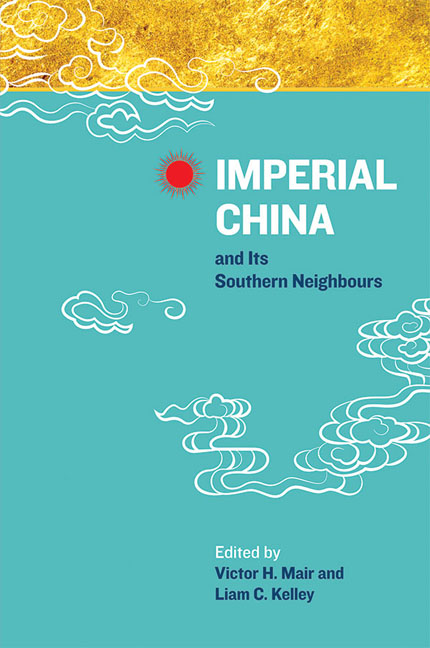Book contents
- Frontmatter
- Contents
- Preface
- The Contributors
- 1 Introduction: Imperial China Looking South
- 2 Layers of Meaning: Hairstyle and Yue Identity in Ancient Chinese Texts
- 3 Sinicization and Barbarization: Ancient State Formation at the Southern Edge of Sinitic Civilization
- 4 Clothes Make the Man: Body Culture and Ethnic Boundaries on the Lingnan Frontier in the Southern Song
- 5 What Makes a Chinese God? or, What Makes a God Chinese?
- 6 Dragon Boats and Serpent Prows: Naval Warfare and the Political Culture of China's Southern Borderlands
- 7 Inventing Traditions in Fifteenth-century Vietnam
- 8 Epidemics, Trade, and Local Worship in Vietnam, Leizhou Peninsula, and Hainan Island
- 9 Southeast Asian Primary Products and their Impact on Chinese Material Culture in the Tenth to Seventeenth Centuries
- 10 New Evidence on the History of Sino'arabic Relations: A Study of Yang Liangyao's Embassy to the Abbasid Caliphate
- 11 The Peacock's Gallbladder: An Example of Tibetan Influence in Late Imperial China
- 12 Transformation of the Yunnanese Community Along the Sino–burma Border During the Nineteenth and Early Twentieth Centuries
- 13 How the North Tried to Pacify the South Through Ritual Practices: On the Origins of the Guan Suo Opera in the Nineteenth Century
- 14 Realms Within Realms of Radiance, or, can Heaven Have Two Sons? Imperial China as Primus Inter Pares among Sino–pacific Mandala Polities
- Index
- Nalanda-Sriwijaya Series
Preface
Published online by Cambridge University Press: 06 January 2018
- Frontmatter
- Contents
- Preface
- The Contributors
- 1 Introduction: Imperial China Looking South
- 2 Layers of Meaning: Hairstyle and Yue Identity in Ancient Chinese Texts
- 3 Sinicization and Barbarization: Ancient State Formation at the Southern Edge of Sinitic Civilization
- 4 Clothes Make the Man: Body Culture and Ethnic Boundaries on the Lingnan Frontier in the Southern Song
- 5 What Makes a Chinese God? or, What Makes a God Chinese?
- 6 Dragon Boats and Serpent Prows: Naval Warfare and the Political Culture of China's Southern Borderlands
- 7 Inventing Traditions in Fifteenth-century Vietnam
- 8 Epidemics, Trade, and Local Worship in Vietnam, Leizhou Peninsula, and Hainan Island
- 9 Southeast Asian Primary Products and their Impact on Chinese Material Culture in the Tenth to Seventeenth Centuries
- 10 New Evidence on the History of Sino'arabic Relations: A Study of Yang Liangyao's Embassy to the Abbasid Caliphate
- 11 The Peacock's Gallbladder: An Example of Tibetan Influence in Late Imperial China
- 12 Transformation of the Yunnanese Community Along the Sino–burma Border During the Nineteenth and Early Twentieth Centuries
- 13 How the North Tried to Pacify the South Through Ritual Practices: On the Origins of the Guan Suo Opera in the Nineteenth Century
- 14 Realms Within Realms of Radiance, or, can Heaven Have Two Sons? Imperial China as Primus Inter Pares among Sino–pacific Mandala Polities
- Index
- Nalanda-Sriwijaya Series
Summary
This volume is composed of papers presented at the international conference on “Imperial China and Its Southern Neighbours”, organized by the Nalanda-Sriwijaya Centre, Institute of Southeast Asian Studies (ISEAS), Singapore, and held at ISEAS on 28–29 June 2012.
The northern periphery of China, from the late Neolithic and the Bronze Age up to modern times, has been carefully scrutinized, both by Chinese scholars and foreign researchers. Even traditional Chinese sources, such as the standard histories, devote considerable attention to the peoples, cultures, and states of the northern and northwestern border regions of the Chinese heartland. Since the Chinese state began in the northern portion of its current configuration and received demonstrable, formative inputs from the north and northwest, it is understandable that correspondingly greater attention would be paid to the north than to the south, particularly during the early periods of the development of the Chinese nation. In contrast, the southern rim of China has been relatively poorly studied, despite the fact that the languages, ethnic groups, and cultures of the south are every bit as complex, interesting, and important as those of the north.
In this conference, we aimed to remedy this disparity by giving due emphasis to the south as a vital region of social, economic, and cultural interaction between Sinitic and non-Sinitic peoples. First, however, we had to recognize that “the south” has not been a fixed entity or a static, welldefined region during the last three millennia of Chinese history. Rather, it has been defined by a continuously changing, amorphous boundary with the north. Indeed, there has been a gradual encroachment of the north upon the south. This was already documented in modern scholarship more than half a century ago by Harold J. Wiens, China's March Toward the Tropics (1954, also published under at least one other title), and C.P. Fitzgerald, The Southern Expansion of the Chinese People (1972).
A dramatic change occurred around the time of the fall of the Western Jin Dynasty (265–316) and the founding of the Eastern Jin Dynasty (317–420). This was a time of crisis in the northern heartland, one that was precipitated by climatic distress and consequent geopolitical realignments. The net effect was to catapult large numbers of northerners southward, quickening the pace of expansion and assimilation.
- Type
- Chapter
- Information
- Imperial China and Its Southern Neighbours , pp. vii - xPublisher: ISEAS–Yusof Ishak InstitutePrint publication year: 2015

